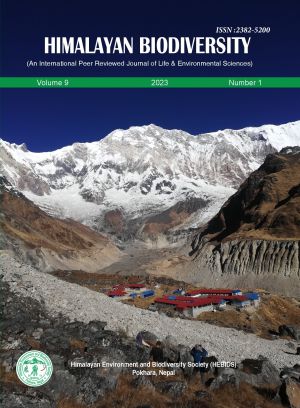Tree Diversity and Regeneration of a Midhill Community Managed Mixed-Forest of Sindhupalchowk, Nepal
DOI:
https://doi.org/10.3126/hebids.v9i1.59576Keywords:
Community forest, Diversity indices, Regeneration, Tree diversity, NepalAbstract
Community forests indeed play a crucial role in the management and conservation of biodiversity, especially in developing countries where poverty can create challenges for enforcing strict rules and regulations. This study focused on analyzing the tree diversity and regeneration in the Anterpu Sallyani Ghaari Community Forest located in the Sindhupalchowk District, Nepal. Data were collected using 30 quadrats, each measuring 10m x 10m, and the sampling method used was random sampling. The study recorded a total of 22 tree species from 16 families. Tree diversity was assessed using the Simpson Index (D) and Shannon-Wiener index (H), and the evenness of the forest was also calculated. Based on the Importance Value Index (IVI), the most dominant tree species were identified as Schima wallichi (DC.) Korth., Pinus roxhborghii Sarg., Castanopsis indica Roxb.Miq., and Lyonia ovalifolia (Wall.) Drude. The overall tree density in the forest was 1080 stems per hectare. The study also reported that the forest has a good seedling density (1310 stems/ ha) but poor sapling density (253 stems/ha). The density-diameter (d-d) curve of adult plants indicated a reverse J-shaped pattern, which is a positive sign as it suggests that the forest is regenerating. However, the low number of small saplings and a slight deviation from the ideal reverse J-shape in the curve indicated unsustainable regeneration. The study suggests that poor management practices and anthropogenic disturbances in the past and present could be contributing factors to the poor regeneration of certain tree species, such as P. roxhborghii. The findings of this study provide insights on the current state of the community forest.
Downloads
Downloads
Published
How to Cite
Issue
Section
License
© Himalayan Environment and Biodiversity Society (HEBIDS)

